oktober 9th, 2010
Mungo Thomson
Negative Space, 2006
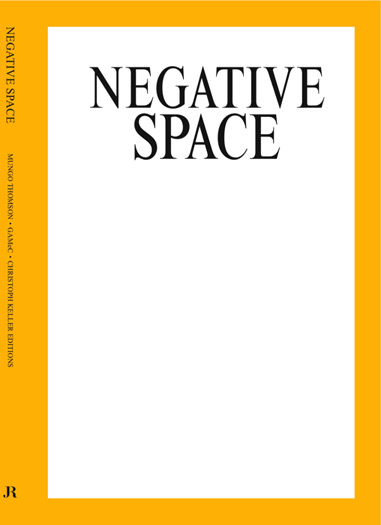
Full color, 160 pages, 10-1/8″ x 7″ x ½”
Designed by Mungo Thomson with Conny Purtill
Published by Christoph Keller Editions and JRP|Ringier, Zurich
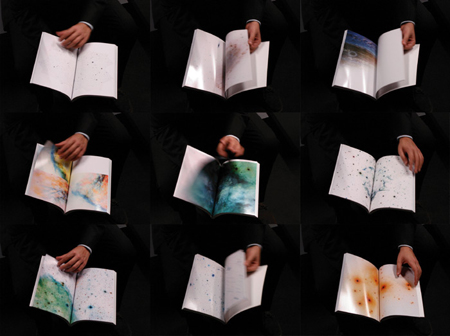
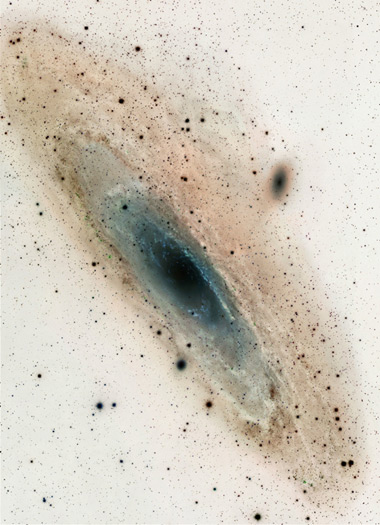
Thomson’s ongoing Negative Space project tempers profound ambivalence with assurances of earnest conciliation. The works in this series—including Negative Space (2006), an artist book, and Negative Space (STScI-PRC2003-24) (2006) and Negative Space (STScI-PRC2007-41a) (2007), large-scale photographic murals comprise psychedelic images culled from an online archive of copyright-free starscape shots taken by the Hubble Space Telescope that the artist downloaded and reversed. (Thanks to a simple Photoshop operation, the inky chasm of outer space becomes the antiseptic pallor of the empty gallery in another act of reversal.)
The Negative Space murals are, as Thomson quips, “like visual whale songs—atmospherics for the spiritually inclined. Wallpaper for Esalen. California all the way.” This means that they are tainted with hippie-stoner associations, but their admission of delight in and curiosity about the world extends well beyond them. In his Gifford Lectures on Natural Theology, delivered at the University of Glasgow in 1985, Carl Sagan described nothing short of the search for the sacred in the universe, beginning with a very simple formulation: “By far the best way I know to engage the religious sensibility, the sense of awe, is to look up on a clear night. . . . I think everyone in every culture has felt a sense of awe and wonder looking at the sky.”
In this way, Sagan opens onto a series of startling observations about the relative unimportance of man in the center of an ever-vaster cosmos—a smallness that is neither a palliative nor a burden, but an invitation born of never really being very sure where it is that we stand. So Thomson offers a site of promise, which aches with entimentality even as its refusal of consolation admits to the impossibility of any easy belief.
– Based on a text by Suzanne Hudson is a New York–based critic and an assistant professor of modern and contemporary art at the University of Illinois.
Dark Matter (Running Man), 2010
Photo-luminescent ink on museum board, 39-¼” x 52”
Dark Matter (Orion), 2010
Photo-luminescent ink on museum board, 44-¼” x 33-¼”

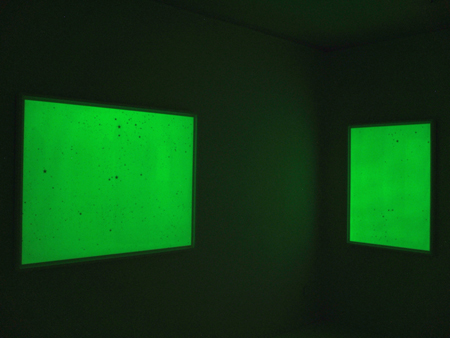
Dark Matter (NGC-6397), 2010
Photo-luminescent ink on museum board, 35-¾” X 27″
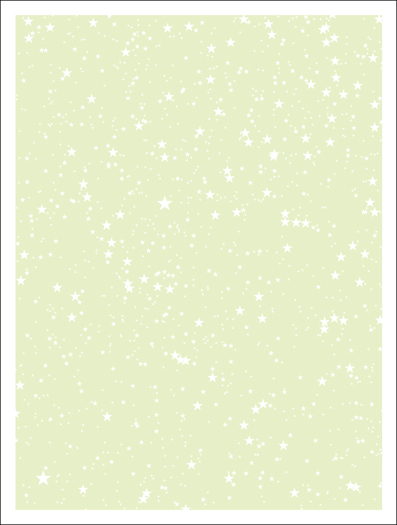
Thomson’s silkscreens invert photographs of starscapes taken by amateur astronomers and turn them into glow-in-the-dark prints whose negative space glows, rather than the stars themselves.
Posted in Cosmology, Visual Arts | Reacties uitgeschakeld voor Negative Space
oktober 4th, 2010
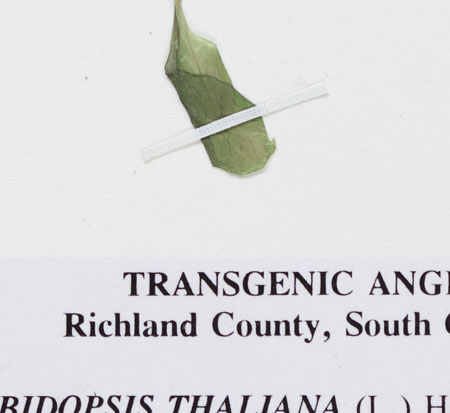
Arabidopsis thaliana is a small unremarkable plant found growing along roadsides, in fields and wastlands of the northern hemisphere. Its apparent simplicity and relatively quick growing cycle made is a good candidate for researchers studying genetics during the middle part of the 20th century. In the 1970′s Arabidopsis thaliana’s life and habitat changed rapidly. Researchers at Stanford University had developed a technique for using bacteria to insert foreign genes into the genome of Arabidopsis. In doing so, Arabidopsis become the first “transgenic” plant. With the advent of the commercial biotech industry in the 80′s, the familiar plant began taking up residence in climate controlled research labs all over the world. It is now considered one of the “standard model organisms” which scientists use to try and understand life, and engineers use to try to find new uses for life.
A single specimen of Transgenic Arabidopsis thaliana rests in the species’ “United States” collection folder in the botany collection at the Smithsonian. Wedge amidst its wilder relatives, it is an oddity amongst its closest kin, but also within the Museum of Natural History on the whole where it remains possibly the only genetically engineered specimen within the collection.
Source: The Center for PostNatural History
The Center for PostNatural History is dedicated to the advancement of knowledge relating to the complex interplay between culture, nature and biotechnology. The PostNatural refers to living organisms that have been altered through processes such as selective breeding or genetic engineering. The mission of the Center for PostNatural History is to acquire, interpret and provide access to a collection of living, preserved and documented organisms of postnatural origin.
Posted in Biology, Ecology, Genealogy | Reacties uitgeschakeld voor Transgenic Life found in the Smithsonian Institute
augustus 6th, 2010
Felix van de Beek
Little Architects, 1979 – 1981
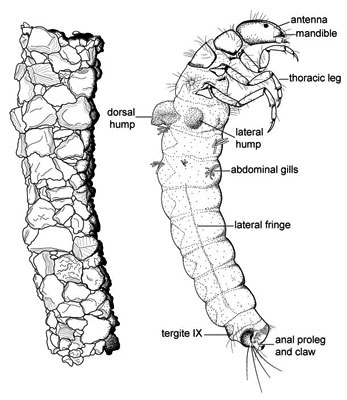
Caddisflies, aquatic insects of the order of Trichoptera are known all over the world. They are tiny nocturnal butterflies whose larvae feed on micro-organisms in non-polluted freshwater. In order to protect an extremely vulnerable abdomen, the larvae of a certain group constructs a portable case or tube consisting of mucus, bits of leaves, sand, etc. Mainly working in nightshifts it takes these one-centimeter-long little architects a week to complete their job. In natural surroundings the cases all look alike. This is not surprising as the material on hand differs very little. But what happens if the supply of stock is changed?
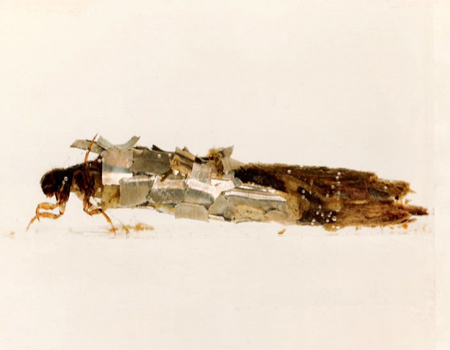
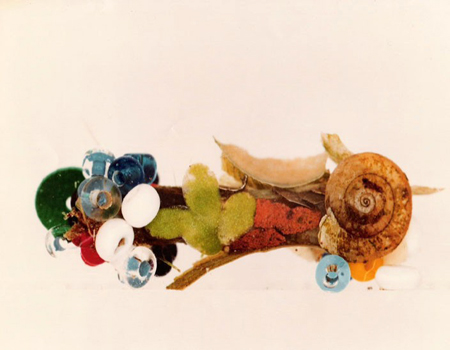
It presented no problem to the grubs. They used everything that was availeable, organic as well as inorganic: ironfilings, wood-chippings, beads, glass-splinters, bits of plastic and so on.
P.S. For the concerned animal lovers in the world: as for the larvae used in the project all flew happily out after the chrysalis stage
Based on a text by Pieter Beek
Posted in Ecology, Visual Arts, Zoology | Reacties uitgeschakeld voor Caddisfly Construstions









